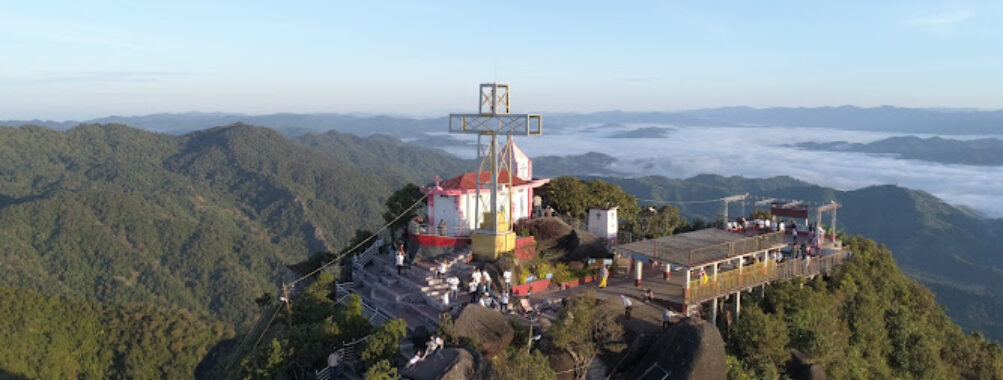
Naw Bu Baw Prayer Mountain
Table of Contents
Description
If you’re the kind of traveler who craves a mix of spiritual calm and a touch of adventure, Naw Bu Baw Prayer Mountain in Kayin State might just be your next favorite spot. Sitting pretty at around 1462 meters, it’s not just a mountain; it’s a place where the air feels different—thicker with peace and tradition. This isn’t your usual tourist trap with crowds and noise; it’s a quiet sanctuary where locals and visitors alike come to find a moment of stillness, away from the chaos of everyday life.
The mountain’s vibe is deeply tied to its spiritual roots. It’s a religious destination, so you’ll see monks and practitioners going about their rituals, and if you’re lucky, you might get a chance to chat with them and get a glimpse into the local spiritual practices that have been kept alive for generations. It’s not just about climbing or sightseeing here; it’s about feeling a connection—to the land, the people, and something a bit bigger than yourself.
Now, don’t expect fancy infrastructure or easy accessibility—this place is raw and authentic. For instance, the entrance isn’t wheelchair accessible, so if you have mobility issues, it could be a bit tricky. But for those who can make the trek, the cool weather (especially in summer and winter) and the lush surroundings make every step worth it. Just a heads-up though: the rainy season isn’t the best time to visit, as the trails can get slippery and the weather unpredictable.
What’s really charming about Naw Bu Baw is how it sits quietly in Thandaunggyi, surrounded by Karen villages and thick evergreen forests. The journey itself, whether by foot or vehicle, offers some stunning views and a peek into the local way of life. There are a handful of guesthouses nearby if you want to stay overnight and soak in the mountain’s atmosphere a bit longer. It’s a place that invites you to slow down, breathe deeply, and maybe even reflect a little.
Key Features
- Stands at approximately 1462 meters, offering refreshing cool weather year-round.
- Deep spiritual significance as a religious retreat and prayer mountain.
- Home to local monks and spiritual practitioners, offering cultural insights.
- Surrounded by lush evergreen forests and traditional Karen villages.
- Accessible via a scenic route from Taungoo, about 27 miles away.
- Several simple guesthouses nearby for overnight stays.
- Not wheelchair accessible, preserving its untouched, natural state.
- Best avoided during the rainy season due to slippery trails and unpredictable weather.
Best Time to Visit
Timing your visit to Naw Bu Baw Prayer Mountain can make a world of difference. If you’re after crisp air and clear skies, the summer and winter months are your best bet. The weather during these seasons is cool and comfortable—perfect for hiking and soaking in those panoramic views without breaking a sweat. I remember visiting during a cool winter morning, and the mist rolling over the valleys was something I still daydream about.
On the flip side, the rainy season is a no-go. Trails get muddy and slippery, and the mountain’s charm kind of gets overshadowed by the constant drizzle and fog. Plus, getting around becomes a hassle, especially if you’re relying on local transport. So, unless you’re a hardcore adventurer who loves a challenge (and a good mud bath), plan around the dry months.
How to Get There
Getting to Naw Bu Baw Prayer Mountain is part of the adventure. Most travelers start from Taungoo, which is roughly 27 miles away. From there, you’ll head towards Thandaunggyi, a small town that acts as the gateway to the mountain. The route takes you through some seriously scenic spots—imagine winding roads with teak forests on one side and rice paddies on the other, sprinkled with quaint Karen villages that seem frozen in time.
If you’re driving, the roads are generally passable, but don’t expect a smooth highway experience. The last stretch might have some bumps and curves that’ll keep you alert. Public transport options exist but can be infrequent, so it’s wise to arrange a private ride or join a tour if you want a hassle-free trip. Once you reach the base, the hike up is about 15 miles from Thandaung to Thandaunggyi, which can be a bit of a trek but totally worth it for the views and the peaceful vibe.
Tips for Visiting
Alright, here’s the real talk. Naw Bu Baw Prayer Mountain isn’t a polished tourist spot—it’s raw, spiritual, and a bit rugged. So, pack accordingly. Good hiking shoes are a must because the trails can be uneven. Don’t forget a rain jacket if you’re visiting near the shoulder seasons, just in case. Also, bring some cash; the guesthouses and local vendors don’t always take cards.
Respect is key here. Remember, this is a religious site, so dress modestly and behave thoughtfully. If you get a chance to interact with the monks or locals, listen more than you speak—you’ll learn more that way. And trust me, the stories and traditions they share are worth every minute.
One of my favorite things about this place was the unexpected hospitality. The locals are genuinely warm, and even if you’re a bit shy or unsure, they’ll make you feel welcome. Staying overnight at a guesthouse gave me a chance to experience the mountain’s quiet magic after sunset—a totally different world from the daytime hustle.
Lastly, don’t rush it. Naw Bu Baw is about soaking in the atmosphere and letting the place work its quiet magic on you. Whether you’re there for spiritual reasons or just to escape the noise, give yourself time to wander, reflect, and maybe even find a little peace you didn’t know you needed.
Location
Places to Stay Near Naw Bu Baw Prayer Mountain
Find and Book a Tour
Explore More Travel Guides
No reviews found! Be the first to review!